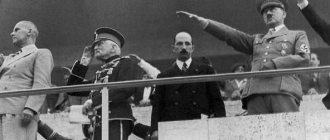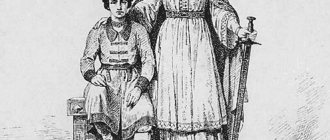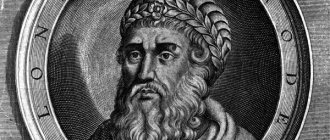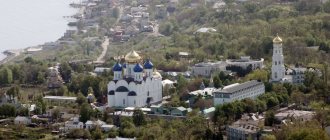| Konstantin and Irina. Fragment of the fresco “VII Ecumenical Council”. Painting of the Cathedral of the Nativity of the Virgin Mary at the Ferapontov Monastery. 1502 Master Dionysius |
Irene of Athens
(Greek Εἰρήνη; early 750s - 803), Byzantine empress (September 9, 780 - December 790, January 792 - October 31, 802), restorer of icon veneration, blessed saint Memory August
9
[1]
Irina was related to the Serandapikh clan, which descended from Visir, the closest ally of the emperor. Leo III the Isaurian (717-741). The clan belonged to the so-called. the new nobility that emerged under the emperors of the Isaurian dynasty [2]. Apparently, the decision of the imp. Constantine V marrying his son and co-emperor Leo IV to Irene demonstrated the continuity of the policies of Constantine and his father. On November 1, 769, Irene arrived in Constantinople by ship from Athens. On this basis she was usually considered an Athenian
, however, this does not follow from the source (“Chronography” of Theophanes the Confessor). Athens could have been the place of service of her father, about whom information has not been preserved (by 769 he had already died). In 798, in any case, the patrician Constantine Serandapich served in Athens [3]. The Serandapich family was undoubtedly part of the highest aristocracy of Constantinople.
After the solemn meeting, Patriarch Nikita I of Constantinople performed the betrothal of Irina to Leo in the palace Pharos church. On December 17, Irina was crowned Augusta (a description of this ceremony was preserved in the treatise of Emperor Constantine VII Porphyrogenitus “On the Ceremonies of the Byzantine Court” [4]), and then the wedding took place.
Sole ruler
During the sole reign of Leo IV (775-780), Augusta did not play a significant role, and even during the coronation of their son Constantine VI in 776, she remained in the choir of the Church of St. Sophia and did not go to the pulpit, which emphasized her secondary position. That is why Theophanes begins the story about Irina’s regency with these words: “In this [780] year, the most pious Irina, together with her son Constantine, amazingly receives the kingdom from God” [5]. Apparently, Irina’s rise to power was the result of a compromise between various political forces, which predetermined the instability of her position in the future. In the history of Byzantium there were precedents for a short-term female regency (Procopius in the 5th century, Martina in the 7th century), but not the sole rule of a woman; Thus, Irina became the first woman in the history of the empire to rule individually in her own name.
Immediately faced with a conspiracy in favor of Caesar Nicephorus, brother of Leo IV, Irina showed decisiveness and forced the other brothers of Leo IV to become monks and accept the priesthood (Nicephorus was exiled to Chersonesos). At the beginning of her reign, Irina managed to reach an agreement with the future Frankish emperor. Charlemagne about the engagement of his daughter Rotruda to Constantine VI. The motive was probably the presence of a common enemy for the two states - the Lombards of Southern Italy. Byzantium immediately benefited from this agreement, since at the beginning of 781 an anti-government uprising of Elpidius broke out in Byzantine Sicily, the leaders of which could no longer count on the help of the Franks and were, albeit with difficulty, defeated. However, the transfer of Byzantine troops from Asia Minor allowed the Arabs, led by Caliph Harun ar-Rashid, to reach the Sea of Marmara, and peace was bought only at the cost of an annual tribute of 70 or 90 thousand nomism. Irina used the three-year respite for military operations in the Balkans, where she sent her favorite eunuch Stavrakis. These actions were an important step in the subjugation of the Slavic tribes to Byzantine rule. Irina was able to visit Verria, renamed Irinople, and Philippopolis, without military clashes with the Slavs, which was previously impossible. She also fortified the important coastal city of Anchial.
Restoration of icon veneration
On August 31, 784, Patriarch Paul IV of Constantinople, allegedly without the knowledge of the empress, under the pretext of illness, left the department and retired to the Flora monastery. Irina took advantage of this situation in order to finally achieve reconciliation with the “old” nobility, who were in opposition to the Isaurian dynasty. An indispensable condition for this was the restoration of icon veneration, but any steps of this kind had to meet very serious resistance in court and military circles. Nothing is known about Irina’s attitude to the veneration of sacred images. Reports from later sources that she allegedly secretly worshiped icons during the life of Leo IV are an obvious projection of stories about the blessed one. imp. Theodora, who secretly from her husband, the iconoclast Emperor Theophilus, prayed in front of the icons hidden on her half of the palace. One way or another, what happened after the departure of Patriarch Paul looks like a well-prepared dramatization. The Empress arrived at the Flora Monastery with her son and began to reproach the Patriarch for his action. To this he replied: “Oh, that I had never ascended to this pulpit, when the Church of God is subjected to tyranny, cut off from the rest of the Catholic sees and anathematized.”
. Then Irina sent the patricians and elected synclitists to him, to whom Paul declared the need to convene an Ecumenical Council to correct their error. Thus, an open discussion of the issue of icons and the convening of the Council was initiated. The next year, after the death of Paul, proto-asicritus Tarasius, a representative of one of the oldest aristocratic families of Constantinople, became patriarch. Most researchers consider Tarasius as a confidant or even a creature of Irina, but it is much more likely that behind him stood the “old” nobility, who regained control of the patriarchal throne, which was deprived of it by the emperor. Leo III, who deposed Patriarch Herman in 730. Irina, in exchange for installing Tarasius, acquired the support of a very influential group in Byzantine society. The election of the new patriarch was arranged in such a way that he received the formal trust of “the whole people.” On the one hand, this allowed him to put forward the convening of an Ecumenical Council as a condition for his appointment, and on the other hand, it gave him a certain independence from Irina. The cathedral was beneficial not only to Tarasius and supporters of icon veneration, but also directly to Irina, since it gave her the necessary legitimation: cathedral acts had to have the inscription: “Under the blessed sovereigns Irina and Constantine.” The first attempt to convene a Council was made in 786 in Constantinople, but soldiers of the tagmas (guard units based in the capital) disrupted the meeting, threatening to kill the patriarch and all Orthodox bishops and abbots. The next year, Irina led the tagmas outside of Constantinople under the pretext of a campaign against the Arabs, while the capital was occupied by thematic troops. The tagmas were then disarmed and disbanded. This made it possible to successfully hold the VII Ecumenical Council in Nicaea in September-October 787.
First resignation from power
Meanwhile, relations with the Franks deteriorated. Constantine's engagement to Rotruda was terminated, and military operations began in southern Italy, in which the Byzantines were defeated. Constantine VI, who had reached adulthood by that time, strove for power and organized a conspiracy against Stavrakis. However, the plan was discovered, and Constantine's supporters were subjected to reprisals. Irene then attempted to have all the themes swear an oath that they would not accept him as the reigning emperor. Under duress, all the themes swore allegiance, except for Armeniacus, whose stratiots imprisoned their strategist and proclaimed Constantine the sole emperor. The rest of the themes then followed their example. Gathering in October 790 in Atroa (Bithynia), the thematic troops demanded that Constantine be sent to them. Irina had no choice but to agree. In December, he entered the capital, removed Irina from power and exiled all the eunuchs close to her. Stavrakiy was tonsured a monk and also exiled. Irina was placed under house arrest; she lived in the palace of Eleutherius, built by her, in Constantinople. In January 792, Irina again received the status of co-regent, but not real power. St. Theophan of Sigrian, who is generally well-disposed towards Irina, claims that it was at her instigation that Konstantin committed various unseemly acts, including divorcing his wife Maria of Amnia, with whom Irina herself arranged the marriage. This fact is very likely, since Constantine's new wife, Theodota, was Irina's cuvicularia (maid of honor). However, when the Monks Plato and Theodore the Studites opposed this marriage, Irina, according to St. Feofana, defended them, “because they opposed her son and disgraced him” [6].
Return to the throne
In September 796, Irina and Konstantin went to the waters in Prusa. At this time, Constantine was informed that his son had been born, and he hastily departed for the capital. Taking advantage of his absence, Irina won over the tagma commanders and other dignitaries to her side. In July 797, when Constantine returned from an unsuccessful campaign against the Arabs, some Tagma soldiers tried to capture him. Then he crossed to Asia Minor to gather thematic troops. Irina, according to Rev. Feofana, was very frightened by his intentions and thought to send bishops to him to receive guarantees of immunity, and then retire. However, among those accompanying the emperor were Irina’s people, and she let them know that she would hand them over if they did not deliver Constantine to the capital. On August 15, he was transported to Constantinople and imprisoned in the palace. There, on August 19, Konstantin was blinded in a very cruel way, which is why he soon died. The sole reign of Irina began, who, due to the unprecedented situation, began to be titled “Emperor (male) Irina” (Greek: Εἰρήνη βασιλεύς).
Sources give very little information about the events of 797-802. Irene's foreign policy was mainly aimed at concluding peace agreements with the Franks and Arabs, in which the empress was at least partially successful. Irene, however, had to come to terms with Charlemagne's coronation as emperor in December 800. Message from Rev. Theophanes that Charles proposed to Irina to marry and thereby unite the Eastern and Western empires is the subject of scientific debate. An embassy from Charles arrived in Constantinople in 802, shortly before the overthrow of Irene. State administration at this time was in the hands of Irina’s favorites, the eunuchs Aetius and Stavrakius, who had returned from exile, who were constantly at odds with each other, striving to ensure that after Irina’s death the throne went to relatives. Having failed to achieve his goal through court intrigue, Stavrakiy began to prepare a conspiracy, but Irina and Aetius prevented his plans, and he soon died. Aetius, having received all power, antagonized the Constantinople nobility (including the Serandapikh family), which predetermined the fall of Irina.
Abdication and exile
On October 31, 802, Nicephorus I was proclaimed emperor as logothete henikon (Minister of Finance). According to St. Theophanes, he promised Irina to leave her in the palace of Eleutheria in exchange for the release of all the royal treasures, but he did not keep his word and exiled her first to the island of Prinkipo (Prince's Islands) to the monastery she founded, and then to the island of Lesbos, where Irina died. The message about the possibility of such a transaction looks very doubtful, especially considering the extreme bias of the chronicler in relation to Nikephoros. Irina’s financial policy was characterized by significant tax breaks, especially in favor of monasteries and charitable institutions, so Nikifor, in order to replenish the treasury, had to resort to strict collection of arrears. In March 801, Irene exempted the inhabitants of Constantinople from taxes for a year and reduced customs duties levied at the entrance to the Bosporus and Dardanelles. Such measures aimed at winning support for Irina’s unstable regime could not but lead to the breakdown of the state. finance.
Irina died on August 9, 803 on Lesvos and was buried in a monastery on the island of Prinkipo, but between 861 and 864 her body was already in a sarcophagus made of Prokonesian marble in the so-called. Heroon of Justinian in the Church of St. Apostles in Constantinople.
For the Byzantines of the 9th century, the question of whether the cruel blinding of Constantine VI was carried out with the knowledge of Irene was extremely important. St. Theophan of Sigrian, a contemporary of the events, absolutely unequivocally answers this question in the affirmative: “...by decision (γνώμῃ) of his mother and her advisers” [7]. However, many other writers of that time (St. Theodore the Studite, St. Methodius, Patriarch of Constantinople, and some hagiographers) in relation to Irina clearly proceed from the fact that Irina was not involved in this execution. The answer can be found in the “Chronicle” of George the Monk. In its original version, created in 846/7, the story about Irina’s reign ends with the following phrase (this part of the “Chronicle” was preserved only in the Church Slavonic translation of the 14th century, called “Letovnik”): “ And she informed those who were all about to die with terrible slander, as if filial blindness could not be more honorable"
[8], i.e.:
“[Irina], being near death, with terrible oaths informed those present that she was not involved in the blinding of her son”
(translated by D. Afinogenov).
One of the important religious events during the reign of Constantine and Irina was the transfer of the relics of Euphemia the All-Praised, VMC. Chalcedon, in 797 from the island of Lemnos to Constantinople. Discovery in 781 in Thrace of a sarcophagus with the inscription: “Christ will be born of the Virgin Mary, and I believe in Him. With Konstantin and Irina, oh sun, you will see me again.”
- should be considered a staging with the aim of legitimizing Irina’s regency.
The main source of information about Irina’s reign is the “Chronography” of St. Theophan of Sigrian. In addition, important information is contained in the acts of the VII Ecumenical Council, the “Chronicle” of George Amartol, and other historical works of later times. Irina is often mentioned in hagiographic monuments created by her contemporaries, or in the lives of contemporary saints. Hagiographic sources do not contain additional information about the reign of the empress, however, unlike the Chronography, the author of which was critical of Irina, they create an image of a pious ruler.
Reverence
The anonymous Life of Irina [9], published by F. Alken [10], was preserved in a single manuscript [11], which this researcher dated to the 11th century, I. Shevchenko - mid. XII century, and J. Dumezh - XIII century. The title of this work indicates the rank of Irene’s holiness: “The Life of the Venerable Irene of Athens.” The first 24 sheets of text are based on the “Chronography” of St. Theophan the Confessor (the Life of Philaret the Merciful, written in 821/822, was also used), the last three pages are from an unknown source. A number of episodes were removed from the Chronography, for example. about Irina’s role in the blinding of Alexei Musele. As W. T. Tredgold showed, the author of the Life of Irene used the correct manuscript of the Chronography, which in some cases gives more correct readings compared to the surviving copies of this historical work [12]. The final part of the Life, where an unknown source is used, speaks of Irina’s exile and death. On the island of Prinkipo, the empress founded a monastery, which she entrusted to the abbess with a “foreign image and name” before leaving for Lesbos. In this monastery in the chapel of St. Nicholas the Wonderworker in the Church of St. Irina bequeathed to the Mother of God that she should bury herself. There, according to the Life, Irina’s memory was celebrated annually with the singing of hymns ([13]). According to Tredgold, the Life was compiled in this monastery before Irina’s reburial in the church of St. Apostles in Constantinople between 861 and 864.
Memory of Irene in Byzantine and Greek calendars
A brief mention of Irina (sometimes together with Emperor Pulcheria) with an indication that on the day of her memory a solemn service is performed in the Church of St. Apostles (where her tomb was located), found under August 7 in the Patmos and Jerusalem lists of the Typikon of the Great Church of the 9th-11th centuries [14], in the Minology of the Emperor. Vasily II con. X - start 11th century [15], in the Synaxarion of the Church of Constantinople at the end of the 10th century [16] and in a number of other Byzantine Synaxarions, including verse ones [17]. However, based on the verse Synaxarion of Greek. printed Menaion (Venice, 1591) and “Synaxarist” by St. Nikodim Svyatogorets was not included in Irina’s memory. Irina is not mentioned in the modern Greek liturgical Menaion and in none of the Greek hagiological codes of the 19th-20th centuries (K. Dukakis, Metropolitan Sophronius (Evstratiadis), Archimandrite Matthew (Langis), etc.), with the exception of the “Byzantine Eortologion” M Gideon [18]. But in the newest of the collections of lives - “The New Synaxarist”, compiled by Hierarch. Makariy Simonopetrit, provides a memory of Irina with brief biographical information [19].
Under August 9, the memory of Irina Nova is indicated in the Patmos list of the Typikon of the Great Church of the 9th-10th centuries [20] and in the Synaxarium of the R family according to the classification of I. Delee [21].
From the Greek protographs, the memory of Irina, on August 7, came into the Slavic-Russian Prologues and was then included in the Great Menaion of Chetya [22], but in the modern calendar of the Russian Orthodox Church the memory of Irina is not contained. However, her memory on August 9 is included in the “Handbook of the Clergyman” (1979) and in the “green” Menaion of the Moscow Patriarchate [1].
Veneration of Empress Irene in Lesbos
According to local oral tradition, Irina, exiled to Lesbos, repented of her sins. In memory of her son, she planted a walnut tree, which she watered with tears. Subsequently, from under the roots of this tree a spring gushed out, which exists to this day. Many sick people received healing from its water, for example, the recovery in 1425 of Akindinus, the son of the local archontissa Melpomene, was documented. The Most Holy Theotokos appeared to Irina and ordered the construction of the monastery of the Nativity of the Virgin Mary on the Carian Hill (τῶν Καρυῶν). In 1235, the monastery was destroyed during a pirate raid. At the beginning of the 15th century, Irina repeatedly appeared as a monk. Reuben (+ 1455), prompting him to restore the monastery; currently on that site is the monastery of Saints Raphael, Nicholas and Irene.
The name of Irene is also associated with the construction of the monastery of the Blessed Virgin Mary Trulloti in Pyrgi Thermis near Mytilene.
However, Irene is not included among the local Lesbos saints [23].
Origin. Early years
Brother and sister Godunov had the honor of being raised with the children of Ivan the Terrible. They got into the royal chambers thanks to their uncle, who served as a bed servant at court. The Godunovs came from a little-known Kostroma family. Their closeness to the sovereign family made them exceptional.
From an early age, Irina fell in love with the future Tsar Fyodor Ioannovich, a weak-willed and humble man. Growing up together, they knew everything about each other. The wedding was a matter of time; they got married in 1575, when both were 23 years old. Contrary to custom, Fyodor Ioannovich did not have a bride show; he chose one and only one and was faithful to her to the end.
Literature
- Theoph. Chron. P. 454-480;
- Mansi. T. 12. P. 951-1154;
- RegPatr. 1936. Vol. 1. Pt. 2;
- Georg. Mon. Chron. 1904, 19782; glory version: Georgy Amartol. Letovnik. St. Petersburg, 1878-1881. Vol. 1-3. L. 354 rev. [phototype. ed.];
- SynCP. Col. 277;
- Abu Djafar Mohammed ibn Djarir at-Tabari Annales quos scripsit / Ed. MJ de Goeje. Lugd. Bat., 1881-1898. Ser. 1. Bd. 1-6;
- Mich. Syr. Cron. T. 1. P. 479 [Sir. text];
- Libri Carolini // MGH. Conc. T. 2. Suppl. Pt. 1-2;
- Niceph. Const. Chron.;
- Symeon the Logothete. Chronicon/Ed. S. Wahlgren. V., 2006. (CFHB);
- Genesius. De rebus Constantinopolitanis. Lib. I-IV/Rec. S. Lachmann. Bonn, 1834;
- Cedrenus G. Comp. hist. 1838-1839. 2 vol.;
- Zonara. Epit. hist.;
- Scriptor Incertus de Leone Armenio // Leo Gramm. Chron. 1842. R. 350-352;
- Vita Ioannicii // BHG, N 935;
- Vita Philareti // BHG, N 1511z;
- Vita Tarasii, patr. CP // BHG, N 1698;
- Vita Bacchi // BHG, N 209;
- Encomium Euphemiae // BHG, N 621;
- Vita Georgii, ep. Amastridis // BHG, 668;
- Vita Ioannis, ep. Gotthiae // BHG, N 891;
- Vita Ioannis Psichaïta // BHG, N 896;
- Vita Irenae Chrysabalanton // BHG, N 925, Vita Nicephori, patr. CP // BHG, N 1335;
- Vita Nicetae, hegum. Medicii // BHG, N 1341-1342;
- Vita Theodori Studitae // BHG, N 1754-1755d.
- Diehl C. Figures byzantines. P., 19083. Vol. 1. P. 77-109;
- Musca G. Le trattative matrimoniali tra Carlo Magno e Irene di Bisanzino // Annali della Facoltà di Lettere E Filsofia. Bari, 1961. Vol. 7. P. 83-127;
- Janin R. Irene // BiblSS. 1966. Vol. 7. Col. 887-888;
- Gero S. Byzantine Iconoclasm during the Reign of Constantine V. Louvain, 1977;
- Speck P. Kaiser Konstantine VI.: Die Legitimation einen fremden und der Versuch einer eigenen Herrschaft. Munich, 1978. 2 Bde;
- Hussey JM The Orthodox Church in the Byzantine Empire. Oxf., 1986. P. 44-52;
- Halkin F. Deux impératrices de Byzance // AnBoll. 1988. Vol. 56. P. 6-27;
- Treadgold WT The Byzantine Revival, 780-842. Stanford, 1988. P. 60-126;
- Schreiner P. Reflexions sur la Famille Impérialle à Byzance (VIII-X siècles) // Byz. 1991. Vol. 61. P. 181-193;
- Kazhdan A.P., Talbot A.-M. Women and Iconoclasm // BZ. 1992. Bd. 84/85. N 2. S. 391-408;
- Kartashev. Cathedrals. pp. 373-394;
- Coulie B. Irène // DHGE. T. 25. Col. 1460-1465;
- Vasiliev. Story. 1998. T. 1. P. 153-157;
- PMBZ, N 1439.
You can't stop living beautifully
The outfits of the sovereign's wife were distinguished by sophistication and luxury. Arseny Elassonsky, the archbishop present at Irina Godunova’s reception, describes her attire this way: “The slightest part of this splendor would be enough to adorn a dozen kings.” The empress's crown was decorated with deep purple amethysts and large sapphires. The main hall, later called the Golden Chamber, was skillfully painted in gold and decorated with frescoes depicting the lives of great female rulers: Princess Olga, Saint Helena, Queen Dinara. These chambers became the reception area for many Russian monarchs.
Children
Fyodor Ioannovich and Irina Godunova did not leave any heirs. There were rumors about the tsar's poor health, even foreign doctors were prescribed, but it was all in vain. Their only daughter, Theodosia, born in May 1592, did not live even two years. Queen Irina was pregnant several times, but she was never able to give the Tsar an heir. Centuries will pass until it becomes known that she had a special pelvic structure that precluded normal childbearing.
On his deathbed, Ivan the Terrible bequeathed to his son to marry Irina Mstislavskaya if his current wife turned out to be childless. He understood well that without an heir in the country, a time of unrest and chaos would soon come, destructive for Russia. Queen Irina realized the precariousness of her position. Her older brother Boris came to the rescue: Mstislavskaya was kidnapped from her parents' home and tonsured as a nun against her will.
Nun Alexandra
Queen Irina, freed from the burden of rule, lived within the walls of the monastery for about 5 years. Severe ascetic conditions, a damp, cold cell and meager food did not benefit the not yet old woman.
According to studies of her sarcophagus, nun Alexandra had diseased joints and hereditary pathology of bone tissue. She probably had difficulty moving in recent years. This is also evidenced by the increased content of lead, mercury, and arsenic in her remains. Apparently, the former queen often practiced treatment with ointments in order to somehow relieve the pain.
Holy Queen Irene
Nun Alexandra reposed on October 29, 1603. After her death, her property went to the church; she herself was buried within the walls of the Ascension Monastery in the Moscow Kremlin, like other queens before her. Later, the remains were transferred to the basement of the Archangel Cathedral, where many great princes and kings rest.
For their righteous life, Irina Godunova and Fyodor Ioannovich were likened to Peter and Fevronia of Murom. These saints are considered the Russian symbol of family, piety and mercy.
Martyr Irene of Aquileia, commemoration date: April 29
She, along with her sisters Agapia and Chionia, lived at the end of the third century near the city of Aquileia in Italy. From an early age, the girls were left without parents. When they grew up, many suitors proposed marriage to them, but they rejected them because... in their hearts they had only love for God.
It was instilled in the sisters by priest Zinon. In a dream vision it was revealed to him that he would soon go to the Lord, and the holy virgins would be sent to torture. At the same time, Saint Anastasia the Pattern Maker received exactly the same revelation. After this, she went to the sisters and instructed them to endure all the torments. After some time, the priest Zinon died, and Agapia, Chionia and Irina were captured by the guards of Emperor Diocletian.
When the sisters were brought to him for trial, he invited them to forget their faith and renounce Christ. But the martyrs did not want to hear about it. Diocletian was going to Macedonia at that time and ordered that the holy virgins be taken with him so that their fate would be decided by the local ruler Dulcytius. Seeing the beauty of the sisters, he was inflamed with an unholy passion for them. He ordered them to be taken into custody and promised freedom if they fulfilled his wishes. But the martyrs refused. Then Dulcitius decided to secretly sneak into their dungeon at night, but before he could open the door, he was struck by an invisible force, after which he was deprived of his reason. On his way out, he accidentally walked into a bakery and got covered in soot. When he saw himself in the mirror, he decided that this was the result of the sisters' witchcraft.
| Then Dulcytius decided to take revenge on them. The next day he ordered them to be brought to trial. But they had to appear before him naked. No matter how hard the warriors tried, they could not remove the clothes from the maidens. Emperor Diocletian learned about this incident, he became furious and handed the holy sisters over to judge Sisinius. Starting the interrogation with his younger sister Irina, he forced her to renounce Christ, but she stood her ground. Then he proceeded to Chionia and Agapia. But they also stood firm in the faith. Sisinius ordered the two sisters to be burned and Saint Irene to be left behind. In the fire, Chionia and Agapia received the crown of martyrdom. The next day Irina was brought to Sisinius. He told her that if she did not renounce, she would be sent to harlotry. But Irina replied that even if her body was subjected to violence, her soul would still be given to the Lord. When she was taken to a depraved house, the guards were overtaken by two bright young men. They said that Sisinius ordered Irina to be sent to the mountain and left there. That's what they did. When the judge found out about this, he was furious, because he had not said anything like that and ordered to go after her. When a detachment of soldiers approached the mountain, they saw Saint Irene on it. They searched for a long time for an approach to the mountain, but never found it. Then one of the warriors shot at her with a bow. So the holy martyr departed to the Lord. | Icon of the Holy Martyr Irene of Aquileia |
Queen Dowager
Fyodor Ioannovich died on January 7, 1598, without leaving behind a single document on succession to the throne. Boris Godunov, in collusion with Patriarch Job, announced to the boyars the desire of the late sovereign to place his beloved wife on the Russian throne. Fearing the terrible time of interregnum, the Duma agreed to swear allegiance to it. So Irina Godunova, the Queen of All Rus', ascended the throne. Her reign cannot be called long - she was nominally the head of state from January 16 to February 21, 1598. Already on the 9th day after the death of her husband, the Russian Tsarina Irina decided to become a nun, thereby freeing up the throne for her beloved brother.
Fyodor also told her about going to a monastery in the event of his death, thereby he wanted to protect his wife from conspiracies and sophisticated intrigues of the boyars. Russian Tsarina Irina announced her decision publicly, giving a speech on the Red Porch. The common people begged the empress to stay and rule, but she remained adamant.
King's sister
Irina left the royal chambers and retired to the shadow of the Novodevichy Convent. There she took monastic vows, becoming nun Alexandra. Before the blessing of her brother's reign, already a nun, she continued to rule the country: she received petitions, signed decrees, and gave out instructions. The accession to the throne of Boris Godunov was associated with a real political performance. A whole procession of petitioners arrived at the Novodevichy Convent, where the future tsar was located. The crowd, bribed by Godunov's supporters, begged him to become the head of the state. Boris rejected the crown offered to him several times, but eventually agreed. Irina blessed her brother on February 21, 1598, after which she completely retired. She devoted the rest of her days to worship and charity.











